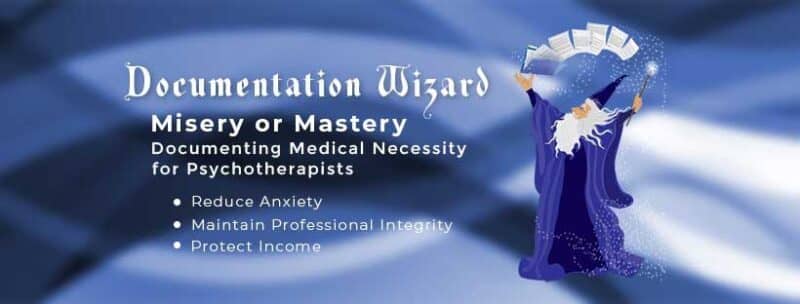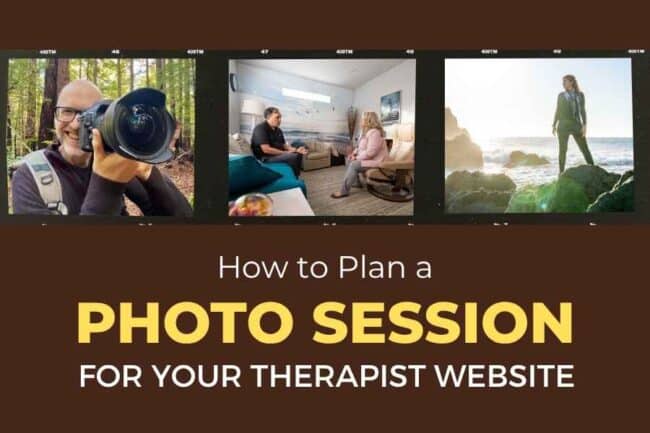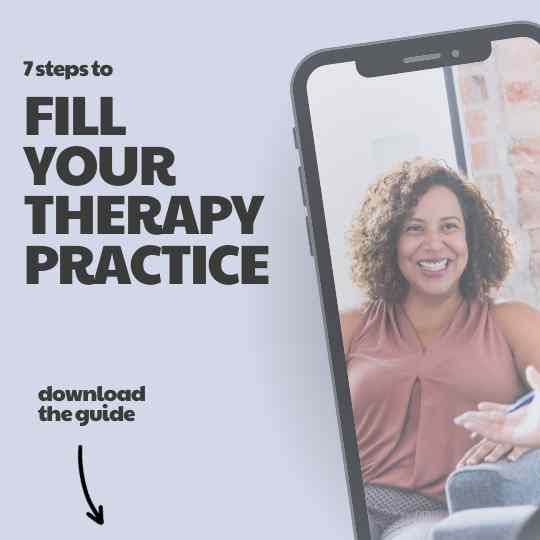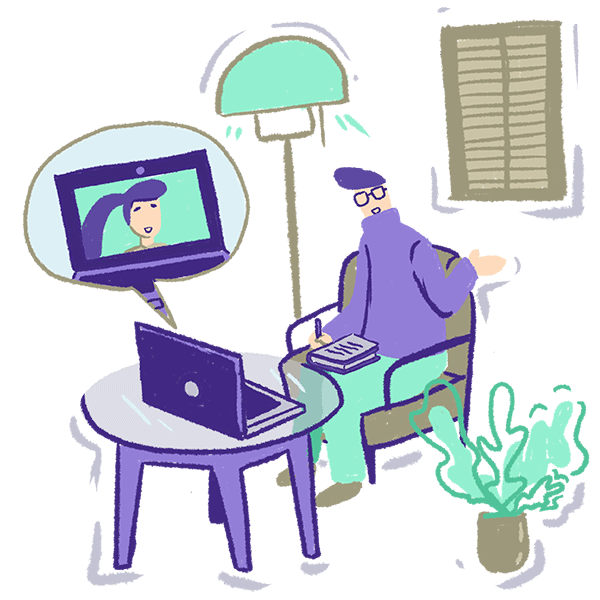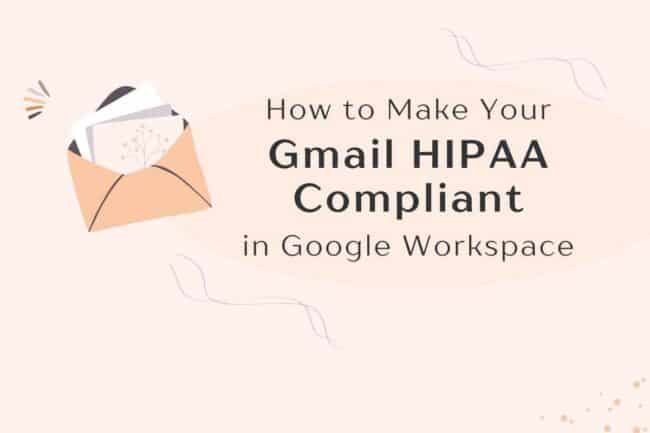Most therapists struggle with “documentation trauma” and “documentation anxiety” when it comes to their clinical notes. In this interview and training session, you’ll learn how to finally break free and master your clinical notes with ease.
Let’s be real … writing clinical notes isn’t why you became a therapist. Yet here you are, with a mountain of paperwork piled up, feeling guilty, anxious, and overwhelmed. You know you need to get them done. But wow, there are just so many ways to distract and disassociate! Sound familiar? You’re not alone.
For most therapists, staying on top of notes feels like an endless hamster wheel. Between back-to-back sessions, phone calls, and life’s daily demands, it’s no wonder you can barely keep up. But, it doesn’t have to be this way!
For more than 20 years, Beth Rontal, LICSW, has been helping therapists like you develop systems for staying ahead of your clinical notes and reducing anxiety.
As the “Documentation Wizard,” Beth uses her years of experience as a therapist to inform her work as a clinical documentation expert and coach.
Just click play below and let Beth teach you practical strategies that will help you stay consistent, reduce anxiety, and finally break free from the weight of unfinished documentation. Or, keep reading for five key takeaways.
Watch the Interview & Training
5 Key Takeaways for Mastering Clinical Documentation
Perfection Isn’t the Goal — Progress Is
- Accept that you won’t finish every task perfectly. Instead, focus on consistent progress.
- Forgive yourself for incomplete work. Holding on to guilt only adds stress and hinders productivity.
- Shift your mindset to prioritize moving forward, even if things aren’t perfect.
Find Community and Accountability
- Join co-working sessions or form accountability groups to tackle documentation alongside peers.
- Working in a shared, structured environment fosters focus and makes it easier to stay on top of your notes.
- The sense of community can reduce the isolation of solo practice and provide motivation to finish tasks.
Schedule Documentation Like Client Sessions
- Set aside dedicated time blocks for documentation—just as you do for client sessions.
- Protect this time as non-negotiable. Stick to your schedule, and make it part of your routine.
- Writing notes consistently, either right after sessions or during planned times, prevents backlog.
- Consider writing concurrent notes by asking clients at the end of sessions, “What are you taking away from today?” This can help guide your documentation.
Use Client Language in Your Notes
- Capture the client’s own words during sessions. Their language offers valuable insight for both clinical and documentation purposes.
- Writing down specific phrases or descriptions helps ensure your notes are both relatable and accurate.
- Client language in notes can also help you better connect with future clients when used strategically in your therapist marketing.
Support Is Key to Success
- Build a support system of peers, mentors, or colleagues who can keep you accountable.
- Recognize that asking for help is not a weakness—having support makes it easier to maintain consistency.
- Engage with structured groups or sessions, such as co-working days, to help you stay focused and get your notes done without added stress.
By applying these key strategies, you can not only get caught up on your notes but also stay on top of them, reducing anxiety and making documentation a manageable part of your routine.
About the Participants
Beth Rontal, LICSW • The Documentation Wizard

Beth’s work focuses on creating systems that simplify documentation, ensuring it not only meets legal and ethical standards but also enhances clinical effectiveness.
Her innovative approach has helped countless therapists reduce stress, pass audits, and protect their income. In addition to her documentation expertise, Beth maintains a private practice in Brookline, MA, where she specializes in working with clients struggling with emotional eating.
- Learn more about Beth at documentationwizard.com
- Connect with Beth on LinkedIn
- Follow Beth on Instagram and Facebook
About the Documentation Membership Circle
Need a productivity boost? Documentation Wizard has introduced the Documentation Membership Circle to help. As a Silver Ring member, you have exclusive access to our monthly Dash & Done co-working sessions and our Curated Resource Library.
Whether you’re a little or a lot behind on your notes, join us to catch up and learn how to stay caught up. Our documentation wizard, Beth Rontal, will share her methods for getting notes done in the company of other therapists who are just as committed to the same outcome as you. Come ready to get your notes done together with like-minded friends on Zoom.
Greg Goodman, Therapist Marketing Coach

With a rich background that melds creativity with technology, Greg’s journey began in the realms of photography and graphic design, where he honed his eye for aesthetics and storytelling. His passion for these fields evolved into a deeper calling as he transitioned into web design and marketing, recognizing early on the pivotal role these elements play in building successful businesses.
Greg’s approach is deeply rooted in the belief that every therapist has a unique story to tell and a dream client waiting to hear it.
This philosophy underpins all his work, guiding therapists to not just market their services, but to connect authentically with those they are meant to serve. Under Greg’s leadership, Goodman Creatives has become synonymous with heart-centered marketing, offering services that encompass web design, copywriting, branding, and coaching. His ethos is not just about creating visually stunning websites or compelling marketing campaigns; it’s about crafting a narrative that resonates with both the therapist and their potential clients.
Greg is committed to the success of each client, employing a blend of strategic thinking, creative execution, and ongoing support to navigate the complex digital landscape. His work empowers therapists to identify their niche, articulate their value, and attract their dream clients, turning passion into profit.
Through Goodman Creatives, Greg Goodman has redefined what it means to be in the business of helping others, ensuring that therapists not only find their voice but make it heard in the crowded digital space.
Greg Goodman:
Hello everybody. I’m here today with Beth Rontal, who is the documentation wizard. So what Beth does is she helps therapists reduce anxiety about documentation in their clinical notes. Now tell me if this sounds familiar.
You see clients all day, you know you’re supposed to have your notes, but you don’t have your notes done. And they pile up and they pile up. Well, I think this is pretty common, especially from what I’ve learned from Beth.
I love that she has been helping therapists with her own unique system for almost 20 years to reduce that anxiety. To make, I wouldn’t necessarily say to make it easier, but to make it more consistent to maybe, maybe actually, yeah, easier. I’ll let you say, why am I saying what your system is?
But I think it probably does make it easier as well. And how do you really, how do you get caught up in your notes? How do you stay consistent? So I’m excited to talk with Beth.
I’ve talked with her off the interview before and to just hear a little bit more about her story and her background as a therapist and how she came to this. And then what’s also really exciting is Beth is going to share a little presentation, a little slice of her work to help you. To help you get caught up in your notes, to help you stay caught up in your notes.
So if that seems like something that would be valuable for you to learn how to do that, then stick around. And yeah, I’m gonna pass it over to Beth. Thank you so much for joining me and us today.
And I would love to just hear your, what’s your story? You know, how did you come to this?
Beth Rontal:
Well, first of all, Greg, thanks for inviting me. I really loved sharing this work and the solutions to writing good notes. And I will tell you that if you had told me when I first became a therapist, well over 20 years ago, that I would become the documentation wizard, I would have told you you were crazy.
The only thing I wanted to do was to be a really good trauma therapist. And what do writing notes have to do with being a good trauma therapist? And like everybody else, I didn’t learn how to do my notes in school or on the job.
I have been a dual diagnosis counselor. I’ve done outreach therapy going into people’s homes. I’ve worked in a clinic, in a hospital, in EAP.
I’ve worked in locked units. I’ve worked in a bariatric surgery unit and nowhere did I learn how to do notes. And in fact, here’s what my training looked like.
My clinical supervisor, who I really like still, my very first clinical supervisor said on my first day, hey, Beth, you want to learn what paperwork you need to do when you have your first session. And I was going into people’s homes. So that was already really different.
And I say, yeah, sure, absolutely. So he says, come here, I’m going to show you. And he walks me over to this wall of cubbies with about 36 different sections.
And he starts pulling out the paperwork like this. And he hands me a stack of paperwork. He says fill this out on your first session.
No guidance at all. And I think that that is how most therapists are trained. Then they do the paperwork, they show it to their supervisor, and their supervisor says, why didn’t you do this?
And why didn’t you do that? And before you know it, you’re being told that you’re not doing it right. And it’s very demoralizing.
I didn’t know how to do documentation until I became a clinical supervisor. And I supervised at this clinic for over 11 years. I think I supervised over 50 therapists from interns to seasoned clinicians.
And one of my jobs was to help the clinic develop its first documentation, digital documentation system. And then train my supervisees on how to use it. So I went into this kicking and screaming.
I did not understand, but if I had to help create the system and if I had to teach the system, it needed to make sense and be a contribution to clinical practice. And so that has become my mission. To teach clinical documentation so that it not only will pass audits and protect you in board complaints, but be useful clinically.
But before that, it could take me 30 minutes to write a session note. It could take me an hour and a half to write a treatment plan. And we all know that that’s completely unsustainable.
And very, very demoralizing. One of the things we talked about is what’s the thing that is the most frustrating for clinicians? And I would say the thing that’s most frustrating is the difficulty of staying on top of notes.
Staying current and keeping them done, getting them done, and staying caught up. And that’s what I’d like to talk about today.
Greg Goodman:
Awesome.
Beth Rontal:
So if it’s okay, I would like to share my screen.
Greg Goodman:
Sure, let’s get that technology set up here. And I just, I appreciate hearing the cubby story as mind boggling. Like, hey, welcome to, imagine that, any new job. I think of the old image of someone at a desk, pre-digital era, but even digital era, with the wire basket, with the gigantic stack of papers.
And it’s like, OK, first day, here’s this stack. Oh, but here’s this stack, and here’s this stack. And I was just doing the math in my head.
On average, the clinicians that I speak to have goals of anywhere from 20 to 30. A case of 20 to 30, right? So that’s an extra, how many hours are you working a week?
Forty-hour work week, like if you’re in a 9 to 5, it’s a full right, 40-hour work week. Well, if you’re seeing 25 patients in a week, that’s 50 minutes, or we’ll just make it an hour for the ease of math.
That’s 25 hours of client time, then that’s an extra 25 hours potentially of note time. So you just now have a more than a 9 to 5, you have a 50-hour work week.
That’s, as you said, so unsustainable. But just playing with that math in my head, it’s like, wow, like just really, really honing in on the importance of what you do and what you offer.
To cut that down, to optimize, to make it more efficient, to come up with systems. I’m all about systems to help people.
Beth Rontal:
Good documentation is about having a good system. That’s the first thing about knowing the requirements and having paperwork that supports you fulfilling those requirements.
Greg Goodman:
Yeah, so okay, so yeah, I got the button ready, so I’m going to click it. I’m excited. I think there’s going to be a lot of value in what you’re about to share for therapists.
I also love too, for everybody watching, Beth just completed a DASH and DONE day. Is that right?
Beth Rontal:
Yeah, documentation DASH and DONE day.
Greg Goodman:
Documentation DASH and DONE day. And I love this concept because it’s the power of the accountability hour is how I often do it where it’s like okay let’s all get together in the Zoom room or something for one hour.
We’re all just going to set an intention in the beginning and we’re going to work for an hour. It sounds like this was an entire day with almost a hundred therapists who are just making their way through incredible backlogs of notes.
Together with maybe you can explain a little bit about like a couple check-ins here and there. I just thought it was such a neat idea of like the power of just when you have and I bring it up now because you’re talking about the systems, like when you actually have the systems, how much you can actually just get done in one sitting.
Beth Rontal:
Yes. When you have structure and a system, and documentation dash and done day provides a structure. So, and I can explain it a little bit later.
Greg Goodman:
Yeah, here I’m clicking it right now. You ready?
Beth Rontal:
You bet.
Greg Goodman:
Alrighty, you’re on.
Beth Rontal:
All right. So, this is the experience of, you know, just about every therapist I know. We love our work. Of course we love our work and we feel like we’re drowning in notes.
And it’s an awful feeling. And it’s kind of like being on a hamster wheel. You keep trying to get caught up, but you can’t.
There are a bunch of reasons why it’s so difficult to get caught up and stay caught up. I’m going to go through those reasons. The first one is when you get into private practice in particular, there’s a lack of outside structure.
You don’t have anybody sitting over you saying, if you don’t get your notes done, you don’t get paid. That’s the way it was when I was working in a clinic. We had to have our notes done, show that we had our notes done, and then and only then could we get paid.
But in private practice, we don’t have that structure. There’s also, as we’ve mentioned before, an enormous amount of insecurity about what and how much to write because we didn’t learn it. So do I write a whole story because if it’s not documented, it didn’t happen?
Or do I just write as little as possible so that I don’t violate client confidentiality? Or where is the balance? Nobody ever really taught us that.
Another barrier to writing good notes is believing that you don’t know what the right language is. You don’t know what language to use. A lot of therapists think that they have to use all clinical jargon.
And the truth is, we don’t. In fact, the more clinical jargon we use, the more difficult it can be for other people, including the client, to understand what we did. Believing that there’s only one right way to write a note.
There is more than one right way. There’s basically my way, your way. Of course, there are requirements and there’s a structure, but it’s like believing that you have to use clinical jargon in order to do it.
Another thing that gets in the way of writing good notes frankly is just life circumstances. Even if you plan to end your session and immediately write your note, that doesn’t always happen.
You have phone calls. You’ve got collateral contacts you need to make. You need to use the bathroom. You might want to get a cup of coffee.
You might need to take a walk so that you’re refreshed for your next client. You might have young kids or parents who need your attention and you can’t finish them. Life happens. It happens to me.
When we don’t know the requirements, when life circumstances get in the way, we get so demoralized, we procrastinate. And then the anxiety happens. And then we start to feel imposter syndrome.
Like, “I’m not a good therapist because I’m not getting my notes done.” And the truth is, you can be a great therapist and not know how to do your notes. I have consulted with hundreds of great therapists who don’t know how to do their notes.
Not knowing doesn’t make you a bad therapist. It can get you into bad trouble, though.
Greg Goodman:
What that’s just, if I can just share one thing as I’m hanging on your every word and looking at this slide, maybe take away the first checkpoint you got there, but the rest of it is verbatim, the same thing about the hamster wheel of therapist marketing.
And especially when it comes to copywriting, it’s just amazing these, you know, it’s almost like these core parts of human personality, of our psyche, of the insecurity, the imposter syndrome, the procrastination, the life circumstances, the believing you don’t know what to do instead of just trusting instinct, all of it.
It’s just amazing to see so many words that I use and that I work, help therapists work through, like showing up in your business as well. Just want to reflect that, that just the life’s threads that all combine together.
Beth Rontal:
Yeah, well, procrastination isn’t about being lazy. Procrastination is about anxiety, and that anxiety is about not knowing or thinking you don’t know what to do and not believing in yourself.
And that shows up everywhere. When it shows up in our documentation, I like to call it documentation anxiety. I actually think that there should be a DSM code for documentation anxiety because every therapist has it.
There are three things that contribute to it, and we’ve talked about them all. The first one is the lack of training, the lack of knowledge because there’s a lack of training, and then the lack of confidence because there’s a lack of knowledge and a lack of training.
If we stay uneducated and unskilled in this area, it can develop into documentation trauma. That’s another term that I coined. Documentation trauma is when you’re not trained and you are hit with an audit or a board complaint or a subpoena, and we go into fight, flight, freeze, or fawn.
It’s just a natural response to do that because audits and board complaints and subpoenas, we’re not prepared for them. We don’t—we’re not taught how to deal with them in graduate school or on our job.
And if we don’t know how to do our documentation, it goes right to childhood trauma of being yelled at for doing something we didn’t even know we did wrong or could do wrong. And you know, the prefrontal cortex goes right offline and we go into fight, flight, freeze, or fawn.
The way to avoid that is to be trained and to use good templates. And the reason it happens is when we’re not trained, we get behind. Even if we are trained, we can get behind because life happens.
But the next thing I want to talk about is how to avoid getting behind on notes. So the first thing is: learn the requirements. Whether you take a training from me or you take a training from someone else, learn the requirements.
Learn what the golden thread is and how the golden thread can be used to write your notes so that all the requirements are fulfilled in the right way. Use a GoodNote template that will cue you for everything you need.
A GoodNote template is a combination of checkboxes or drop-down menus and prompts with short answers. You can’t just have a template that has checkboxes. It’s not enough because you need to write what you’re doing in your own words.
Some templates just have these big empty boxes that say things like clinical content. And now when I saw that, and when I first became a therapist and I had to write the clinical content, I thought, I have to tell the whole story of what happened in the session because to therapists, everything is clinical content.
I didn’t know how to break it down. So a good note template will break down what is meant by clinical content or clinical assessment.
You also need to get grounded with the facts. So what does that mean? You need to know how much time it takes you to write a note.
We either grossly overestimate or grossly underestimate how much time it takes to write a note. A simple note should take five minutes. Really simple notes, sometimes I can get it done in three minutes.
A more complex note can take 10 minutes to write because we have to think about it. Most of the information is checkboxes and drop-down menus, really short answers. But when it comes to what our clinical assessment is, we’ve got to think.
And that’s a good thing because it allows us to do what I call self-supervision. In other words, think about what happened in the session and why it happened and make sense out of it clinically.
So a simple note, five minutes. A more complex note, 10 minutes. 20 clients a week, 10 minutes times 20, 200 minutes, you know, over two hours.
Put in some time for bathroom breaks and, you know, play Words with Friends on Facebook, or, you know, eat your lunch. Factor in that time.
And just as important, schedule the time and make it as important as the time that you spend doing sessions. When you schedule your time, you can either do it right after your session or you can do it at the end of the day or you can do it at the beginning of the next day.
Or you can write concurrent notes. It’s not something I’m good at, but other people are really good at writing concurrent notes.
One of the ways I recommend at least writing a little bit of concurrent notes is near the end of the session. You just ask your client, “What are you taking away with you from the conversation we just had?”
And that will explain a whole lot about, or that will inform what your assessment is and the progress that your client made for the day. The thing you want to do to avoid getting any more behind than you may already be is to get current and stay current.
Always do today’s notes, and tomorrow, do tomorrow’s notes, which is today’s notes. Even if you’re a year behind, don’t think you have to catch up on that year in order to get current. Just start today and get current.
Don’t even think about catching up on your notes until you have become reliable and count-on-able to stay caught up. It could take you three weeks to become reliable. It could take you three months to become reliable.
Just get reliable. And once you’ve done that, then you can make a plan to catch up. So here’s your catch-up plan. Again, get grounded in reality. You’re going to count the number of clients you have who you need to catch up on, and you’re going to count the number of notes that you have to catch up on.
You’re going to multiply the number of notes by, let’s say, 15 minutes a note, because it takes longer to write an old note than it does to write a current note. Then, you’re going to figure out how much time you need to catch up on your notes.
You’re going to put all your client files in order. In other words, if you have what I call memory notes—the notes we use to trigger our memory from session to session that contain a lot of information that do not go into your medical record—put those notes in chronological order. Get everything organized.
Then you’re going to decide what client you start with. And it almost doesn’t matter, but here are some guidelines to think about which client you start with. You might decide to start with a client who you have the least number of notes to catch up on, so when you do, it’s a great accomplishment.
It happens really quickly. You might decide to catch up on somebody who has court involvement because heaven forbid your notes wind up subpoenaed; you’ll have them done. You might decide to start writing your notes on somebody who’s actually a little difficult so that you gain some clarity in the process of writing your notes because, like I said earlier, note writing can be like self-supervision.
So to repeat myself, it doesn’t really matter who you start with. Just decide. You also may want to create a list of intervention prompts. Here’s how you do this.
Take about an hour, go through a whole bunch of your notes, and write down the interventions that you use—the most common interventions you use—and you can organize them by diagnosis or you can organize them by therapeutic modality. Keep a running list of interventions.
And when your brain stops working at 100%, you can look at that list of interventions and go, “Oh yeah, that’s what I did.” It’s remarkably helpful. So take an hour, play some music, go through your notes, and write your list of intervention prompts.
This is really key. Remove distractions. Turn off your email. Put your phone on mute.
Don’t go into social media—it’s deadly. Every time you’re interrupted by one of those things, it can take you 20 minutes to get back into the groove of what you were doing. It’s actually been proven; there’s a study about it.
Another thing you want to do—and this may come as a surprise to some of you—is know your state statute of limitations on health insurance audits. In some states, insurance companies can only go back one year. In some states, two years.
Some states don’t have a statute of limitations, which means they can go back indefinitely. But for those states that have a statute of limitations on health insurance audits, if you are three years behind on your notes but your statute of limitations is one year, start with your notes at that one-year mark.
Is it good to get caught up on the other two years? Yes, it is in case your notes are subpoenaed for any reason or in case an old client decides to sue you. You know, I’m sorry to be an alarmist—I don’t mean to be—but just know your statute of limitations.
The next thing is: think of note writing as self-care. And here’s what I mean by that. Start and stop your sessions on time.
This is really hard for a lot of therapists. It can even be hard for me, and I practice it. Because when we get near the end of a session, we think, “Oh, there’s just one more little thing I want this person to get.”
If they get it, it’ll make the whole session worthwhile. It may or may not, but going over is not self-care. You need the time to decompress, whether it’s five minutes or 10 minutes or 15 minutes. You need the time.
I think I said this before: make the note-writing time as sacred as the time that you spend with your clients. One of the things you can consider doing is scheduling a couple of 30-minute breaks between clients. So in that 30 minutes, you could eat some lunch, and you can write some notes.
If you don’t do your notes right after seeing a client, write your note writing in your datebook, and again, keep that time as sacred as the time you spend seeing your clients. This takes discipline. It takes discipline to not let other things interfere.
It takes discipline to start on time and stop on time. Your clients will—what you’re doing is you’re actually modeling really good behavior and good boundaries by starting and stopping on time. And there’s also freedom in discipline.
When you know you can count on yourself to do it and to do it well, there’s just less anxiety and less potential for documentation trauma. Whatever you do, however you start, whether you are getting yourself accountable by doing your notes on a daily basis or whether you are catching up on your notes, you need to assess your progress.
And you know, that means being realistic. What did you do? What didn’t you do? Celebrate your accomplishments.
Because I promise you, relentless self-criticism keeps you trapped in that hamster wheel of incomplete notes. That critical part of us wants us to finish our notes. It wants us to be good therapists, but it is so relentless that we rebel, and we don’t do it.
And whatever you do, whatever you accomplish, you will probably never accomplish everything you want to accomplish. Forgive yourself for what you didn’t complete and just move on because nothing else is going to happen if you don’t.
Finally, there are people who will always struggle with getting their notes done on a daily basis—even a weekly basis. Although I hope that you don’t get behind more than a week (although it happens to the best of us for all the reasons I mentioned), you can also join my coworking sessions on catching up on notes together. Greg referred to it earlier, it’s called Documentation Dash and Done Day.
I just did one, and the next one is coming up on May 17th. It’s four and a half hours or five hours of coworking using a structured method to keep us focused. And what I found is when there are other people doing the same thing in a structured, supportive environment, you get it done.
It’s all done on a Zoom call. There’s opportunities to ask me some questions in the chat and to just get your notes done. No shame, no blame, coworking in community.
It’s amazing. I had my first one like a week and a half ago, and you know, half the people said, “Please do it again next week.” I’m like, no, I won’t, but I will do it soon.
So if you want to join us, you know how to do that. I think Greg’s going to put some notes in the, yeah, put the way to connect with me in the notes. And you’ll go from this to this. That is my hope for you.
Greg Goodman:
All right. That was wonderful. Let me remove Miss Piggy from the screen.
Thank you for that. That was everything I had imagined it would be and more—just so value-packed. And it’s inspirational in so many ways too because it sounds—you know, obviously, I’m not a therapist, so I’m not in that world—but I have my own notes and my own things that I put off and procrastinate.
What really resonated with me too at the end was you were talking about the discipline, the freedom and discipline. I wrote it down: when you can count on yourself—and the anxiety and the trauma goes down, right?
And it is, it’s this accountability. And I think about it a lot in myself and with business coaches that I’m with, like this idea of every time that I, you, we, anyone tells ourselves, “Oh, I’m going to do that thing today. I’m going to do that,” and then we don’t do it, we’re lying to ourselves in some way.
We’re also training our brains to not believe the promises.
Beth Rontal:
We’re training our brains not to believe us. Right.
Greg Goodman:
That’s right. And I think the discipline—and I know that I struggle with this in my own life, business and personal life and everywhere—it’s like the discipline of, because it’s, and I’m curious your thoughts, and this is as a therapist, like I feel like for me personally, it’s so much easier to have the discipline in how I show up and serve my clients than it is in the behind-the-scenes stuff.
Like getting out newsletters for me, or working on my own marketing, or going for a walk in the morning when I know I should be moving my body to start my day with that flow of energy and chi and yumminess as opposed to just plopping down at my desk and doing work because I got work to do.
These are how it shows up for me.
Beth Rontal:
Well, what you’re saying points to something that I think is really important. When you have a big goal, you need support. The idea of being a self-made person—I mean, I may offend some people by this statement and I don’t mean to, but I believe it’s nonsense because we all have to have support in order to be successful.
The bigger your goal, the more support you need. I have people on my team supporting me because I can’t do it alone. And I need people to keep me accountable because otherwise, I get lost in my post-it notes.
Greg Goodman:
Yeah, and human beings are not meant to do it alone, right? The whole power of community, it takes a village, all of those sayings and cliches and expressions—they exist for a reason.
We—
Greg Goodman:
We are the social species, and we do better when we have the support, encouragement, and feedback from like-minded people who share the same goals and understandings.
Beth Rontal:
Yes. For some therapists, getting up to speed on their notes, feeling competent at doing them, feeling like they’ve got the skill and staying current is like being an athlete in the Olympics. It’s that hard, right?
But what do Olympic athletes have? Support. They have coaches. They have many coaches.
So, you know, if this is your Olympic gold medal, get coached.
Greg Goodman:
Absolutely. And the other thing too that came up for me as you were talking—and this is one of the things I was thinking about before our call and why I think also from a marketing perspective for therapists, what you do is so critical—is a big part of what I teach, this concept of the “dream client dictionary.”
Right? To create a website, to create a marketing campaign that has emotional resonance. Instead of speaking with jargon, and it goes back to that slide, right?
Like, it’s like, instead of speaking with jargon, it’s “What do they say? What are the words they’re using in session?” So one thing I always suggest to therapists that I work with is, during your session, to think: What are the words? What are the phrases?
What are the metaphors and similes? How do they describe what they’re going through? Because it’s not the DSM version that a lot of times gets written down.
But when you suggest, and this is where what you’re doing is in such beautiful alignment, to go through those clinical notes and in the clinical notes, write down what they’re saying.
And I think one of our conversations that you and I had had, what would you call it? You said, one potential way to do it is a client quotes section. So, if there’s a way to combine clinical notes…
Beth Rontal:
Yes, absolutely.
Greg Goodman:
…and I know these are two different worlds. And of course, I encourage anybody listening to do this within whatever ethics and guidelines you need to follow to make it feel okay for you.
But how to use your clinical notes also as a way to reach a greater or wider audience so that you can help more people, right? For the great, big mission of everything to make the world a better place, to improve our collective mental health, like, in many ways, starts with clinical notes and clinical notes done right—and reducing the anxiety and the stress about them.
Beth Rontal:
You know, what you said about quoting the client in the note and tying it into marketing is actually real. And I just want to highlight that.
It’s not about going through one’s notes and looking at what the client says and writing it down to violate HIPAA. It’s about: What is your ideal client working on?
What are their struggles in their own words? When we’re marketing, we’re marketing with the idea of using the client’s own words. At the same time, insurance companies want to hear what the client is working on in their own words.
So, it serves a dual purpose if you are a private practice therapist trying to market your practice.
Greg Goodman:
Yep, I appreciate that additional way of looking at it. Absolutely. And this is what I love about interviews like this and getting to chat with amazing people like you, Beth.
I have a lot of background in working with therapists—I’ve been doing it for almost 20 years—and at the same time, I’m not a therapist.
And I just love that you’re coming to this, not just from a coach and training perspective, but you have the therapeutic background to the point where you’ve coined “documentation trauma” and “documentation anxiety,” right? From your background, of course, it makes total sense to call it that.
There’s just—yeah, I really just appreciate the value and the service you provide and how you help therapists to be better at what they do, to help more people, and to reduce the obstacles that come with running a business.
And I really think you’re a valuable asset in someone’s corner. I’m grateful to have had this time to connect with you and to have you share a little bit with anybody and everybody watching and reading this.
So, I would love, if there’s anything, any other parting words of wisdom you want to share, I’d love to end with that. And before, as Beth said, I’m going to drop your links, your social—you know, I found Beth on LinkedIn.
She’s got her upcoming Documentation Dash and Done Day, as well as all sorts of other resources. There are lots of different ways that you can interact with Beth to reduce the anxiety and the stress surrounding notes.
You can get your notes done, and you can come up with systems for sustained success, so it’s not always just trying to squeeze it in and feeling like a sacrifice.
Beth Rontal:
And you can also get a copy of this PowerPoint. There will be a link to it.
Greg Goodman:
Awesome. So, we need to take notes.
Beth Rontal:
Yes.
Greg Goodman:
All right, well, I want to thank you all for joining. Beth, thank you again.
And if you have any questions, I really encourage you to reach out to Beth directly. She will be there to help guide you as you need.
Beth Rontal:
Thanks a lot, Greg. It’s a pleasure.
Greg Goodman:
Bye-bye.
Beth Rontal:
Bye-bye.
Greg Goodman:
It’s a pleasure. Bye, everybody.
Beth Rontal:
Bye-bye.
Greg Goodman:
Bye-bye.


